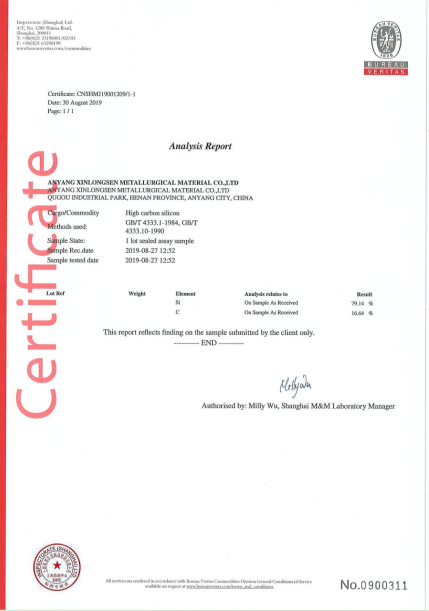- Ferrosilicon
- Silicon metal
- High Carbon Silicon
- Silicon carbide
- Silicon calcium
- Ferroalloy Briquette product
- silica fume
- Carbonizer
- Magnesium ingot
- Calcium silicon alloy cored wire
- Silicon slag
- Nodulizer and Inoculant
- Slag Stopping Ball
- Slag stopping plug
- Nozzl
- Zirconium nozzle
- Hotline
- +86-15517207844
- +86-372-2958995
- Official email:
admin@ayxlsyj.com - Sales mailbox:
sales@ayxlsyj.com
 Industry News
Industry NewsHigh Carbon Silicon, also known as Silicon Carbon Alloy, is a new type of alloy used in converter.
High carbon silicon, also known as silicon-carbon alloy, is a new type of alloy used in converter. It can replace ferrosilicon, silicon carbide and carburizing agent, reduce the dosage of deoxidizing agent, and be used in the process of deoxidizing alloying in converter smelting. The effect is stable. The chemical composition, mechanical properties and internal control quality of steel are better than those of traditional process.


Production process:
High-carbon silicon, also known as silicon-carbon alloy, belongs to the subsidiary product of metal silicon. Because the temperature near the bottom and wall of the furnace when producing metal silicon can not reach the original standard temperature of fully melting metal silicon, more and more metal silicon which can not be completely chemically reacted is pasted on the bottom and wall of the furnace, so high-carbon is produced. Silicon.
How to use high carbon silicon:
For a long time, the alloy used in converter has not been adjusted. The structure of traditional alloys is relatively single, that is, Q195 and Q235 steels adopt Mnsi+FeSi+SiAiCaBa+Sic+carburizer process, HRB335 and HRB400 steels adopt MnSi+Fesi+AiSi+carburizer process. Traditional Silicon-manganese alloys, with increasingly scarce ferrosilicon resources and rising market prices, have gradually increased the cost of converter steelmaking and reduced the profit margin of steel products. Moreover, the recovery rate of traditional alloys is greatly affected by converter operation. The amount of steel tapping, terminal temperature and slag dropping make the alloy composition fluctuate greatly in the finished products. As a result, the chemical composition of steels is unstable and the qualified rate of internal control index of finished products is low.
With the advent of high carbon silicon, more and more steel mills began to use high carbon silicon. Generally, the rated grain size is 10-100mm (90%) or 10-60mm (90%). The rated content is two kinds: 1. Silicon: 65% is the least, carbon: 15% is the least, 2. Silicon: 68% is the least, and carbon: 18% is the least.
High carbon silicon can be added to the bottom of the converter before the molten steel is dumped into the converter to ensure a fuller and faster melting.

Prospects:
It can be seen from the application that silicon-carbon alloys have great advantages in replacing some alloys. The demand for silicon-carbon alloys in steel mills is also increasing, so the prospect of silicon-carbon alloys is promising.
Anyang Xinlongsen Metallurgical Materials Co., Ltd. specializes in the production of various ferroalloy products: ferrosilicon, metal silicon, high carbon silicon, silicon carbide, calcium silicate, silicon, aluminum, barium and calcium, etc. With the continuous upgrading and improvement of steelmaking process, our factory is also developing new products, such as calcium silicate core-wrapped wire, high carbon silicon, silicon ball, carbon ball, etc.
More than 20 years of production experience, let us guarantee customers: 1. stable product quality, 2. stable supply quantity.
More than 10 years of export experience, let us guarantee customers: 1. Fast delivery time, 2. Preferential price booking service.

JackWang,Anyang Xinlongsen Foreign Trade Manager. Welcome to consult。
jack@ayxlsyj.com
Cellphone/wechat/Skype:+8615517207844

